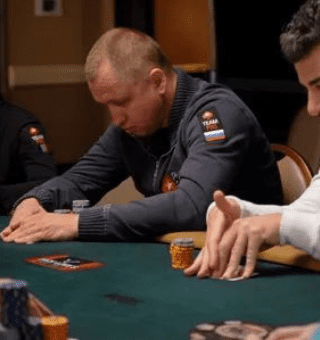
Poker Quick Tips: The Postflop Poker Strategy Bullet Points
We're going to share the second part, which is about the strategies we can adopt as postflop poker strategy. The key to a consistent poker quick tips for Texas Hold'em lies in the ability to cleverly balance the preflop action range and to extend the possibilities postflop to confuse opponents, thereby successfully bluffing and extracting value.
The Postflop Poker Strategy Bullet Points Game Introduction
Welcome back to the poker quick tips for Texas Hold'em. Today, we're going to share the second part, which is about the strategies we can adopt as postflop poker strategy.
The key to a consistent poker quick tips for Texas Hold'em lies in the ability to cleverly balance the preflop action range and to extend the possibilities postflop to confuse opponents, thereby successfully bluffing and extracting value.
Today's poker quick tips for Texas Hold'em also include examples to illustrate the overall hand action strategy.

Poker Quick Tips: Postflop Decides Whether to Control the Pot
Some people will say in a very formulaic way that poker quick tips for Texas Hold'em lack depth, always advising players to control the pot in early positions, making players passive, and opponents are unlikely to pay when there is actual value.
This statement obviously has blind spots because they do not understand the essence of poker quick tips for Texas Hold'em, which is balance.
Let's look at an example:
In a nine-handed table with blinds at 50/50 and a stack of 100, we are in the big blind with Js Jd. UTG+1 raises to 600, everyone folds to us. Here, as mentioned earlier, in early positions, sometimes we can hide our hand strength by calling. I judge that the opponent's hand is probably a pair of 10s or higher, or high cards like KQ/AQ/AK.
If I raise here, according to poker quick tips for Texas Hold'em, my range will appear very tight, because I would not be afraid of a re-raise from the UTG+1, so the hands that can continue would all be strong. Conversely, if I just call, I can decide my action based on the community cards. If the community cards do not reveal high cards, we can choose to check-call to keep the opponent's bluffs in play.
I call, and UTG+1 folds. Heads-up to the flop with a pot of 1350.
The flop comes 10h 5h 3c. After I check, the opponent also checks. Here, whether it's protecting a big pair or extracting implied value with an Ace of hearts, I would tend to continue betting. I put the opponent on a hand with an Ace of hearts blocking my hand.
The turn is 3h. After I check, the opponent bets 800, and I call. Here, my calling range is wider, including any pair with a heart higher than 8. I don't have many 3s in the big blind, and there are not many opponents left. Therefore, I believe the situation is still the same as the flop, no change in position between leading and trailing. The pot is now 2950.
The river is 5s. Since the board is paired, if the opponent has an Ace with a heart, it would now be a valuable showdown hand. If I check, I would miss out on a lot of value bets. Also, I have some hands like KX of hearts or QJ of hearts that I might bluff with, and these Ace-high hands can be caught. Therefore, I choose to lead out with a bet of 1000.
The opponent raises to 4200 after some thought. My consideration here is, what range of hands would the opponent have that didn't hide value postflop but beats my pair of Jacks and would raise a bet on the river?
Postflop Poker Strategy Bullet Points
In theory, whether it's a set of 10s, an Ace with a heart, or an Ace with a heart and a 10, a continuation bet on the flop is almost inevitable.
Poker quick tips for postflop poker strategy often require continuation bets postflop to maintain balance when playing from later positions.
Therefore, her lack of a continuation bet is theoretically an Ace with a heart, a blocker, as well as a few 9s/8s/7s that are capped, and a very few QQs that control the pot.
Although my hand is losing to QQ, QQ's raise doesn't really get value from my Ace without a 10, so the target is A/10. But even A/10 on the river is a check-call, so QQ's raise is likely to be met with a bluff. So, QQ should mainly call when facing a donk bet on the river.
Therefore, the most reasonable possibility here is an Ace with a heart. My JJ can call, and after calling, the opponent reveals AhKd. I successfully take down the pot of 11350.
Above is an example to illustrate the action line in early positions for postflop poker strategy. In fact, poker quick tips for Texas Hold'em, whether to check the pot postflop, mostly depends on our judgment of the opponent.
If the opponent is an aggressive player, controlling the pot can indeed create more profits. For example, if the opponent continues to bet postflop, I might go all-in on the turn because the opponent is likely to have an SPR of 1:1.
Of course, when he has KK/AA, I am more likely to pay his value bet. Therefore, there is no absolute method in poker quick tips for Texas Hold'em postflop poker strategy. As long as you can persevere and balance your range, you'll be fine.
₹10,000 EVO First Deposit Live Casino Online Roulette Bonus is here! Claim your casino bonus for the EVO Live game, including roulette, red door roulette... and so on!
All the Baccarat and roulette games you can find in EVO live casino online, you can play with this casino bonus, so don't miss out on the bonus, especially for lighting roulette!




